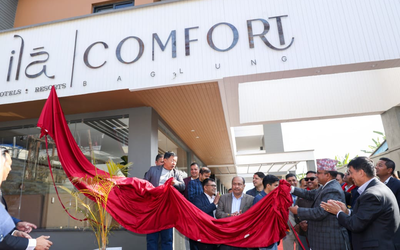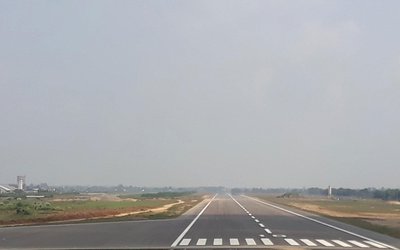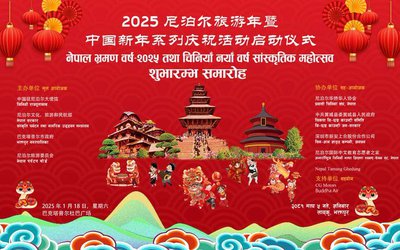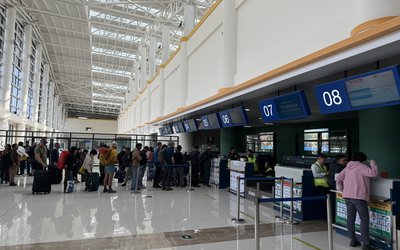
A lot must have come out in the print and shown in the television about Ghale Gaon of Lamjung - the synergistic output of culture and tourism. This is a neat and clean village in which out of 108 households, 77 belong to the Gurung community. The view of a mountain range, the sunset and the sunrise mesmerizes everyone, who has been there. I have overheard a couple speak with their friend about the view of sunrise from Ghale Gaon as better than that from Tiger Hill in Darjeeling. It brought a smile on my face. I have never been to Tiger Hill to watch the sunrise. The sunset here is equally magnificent. The hospitality of Khagan Singh Gurung's family made my stay in Ghale Gaon more enjoyable.
All the microbuses going to Besishahar were packed. That meant no seats, just two days before Tamu Loshar. Chetan, my cousin's son, and I took a microbus which was going to Pokhara and got down at Dumre. Of course, we paid the full fare of Pokhara. The conductor had not left any room for bargaining and we were desperate to reach Besishahar, the district headquarters of Lamjungfrom where the trek to Ghale Gaon starts.
From Dumre, we took a bus to reach Besishahar in about two hours. It was an experience in itself. There was no space to place a foot and there were still more people wanting to climb onto the bus. However, to my amazement, they climbed in and they fitted well inside the bus, despite the fact that there were lots of complaints from the passengers. I had got a seat which I had to offer to a lady carrying a suckling in her pouch. Then I had to struggle in the bus to place my feet in the right spot.
Besishahar is a small town with all the basic facilities. On the way to Besishahar, a fellow passenger Lokendra Bahadur Pariyar, who was a little tipsy, told me that it would take us around 12 hours to reach Ghale Gaon if we chose to walk. When we had started from Kathmandu, we had in mind this trek till Ghale Gaon from Besishahar. There was an alternative way to reach Ghale Goan as well. Travel by jeep. In fact, it was the most popular way to choose. It would take around 3 hours by jeep.
We explored the possibility of trekking till Ghale Gaon and most of the people we talked to suggested that it would take us not less than four hours. We decided to walk. It took us eight hours.
On the way to Ghale Gaon, during our first couple of hours, we met one Sarki Ba. I could feel a tone of social outcast in his speech when we got introduced. When we were exploring the route with him, he showed us a steep hill and told us that we had to climb the hill. That moment, I thought Sarki Ba loved talking and he must be kidding with us. We had noodle soup and omelets and then resumed our walk.
Soon we realized Sarki Ba wasn't kidding. We had to climb uphill some two and a half hours exactly the same hill he was talking about. This was the most difficult climb I had done ever. I was trying to find out which other trek was as challenging as these two and a half hours. Probably the uphill from Jhinu to Chomrong and also one portion during Khaptad trek was.
Once in Baglungpani, we could again see the hustle and bustle of the village and at the background clear view of snow peaks of mountains. We had lunch at Kapur Gaon. It was another three hours’ uphill walk till Ghale Gaon. In between, we came across the winding dirt road which was in use to reach Ghale Gaon.
The road trip would not have given us the satisfaction that we got by trekking. It is a one lane road and it would not have been a comfortable ride.
We stayed at Khangan Sing Gurung's house. Ghale Gaon is well known for home stay. The committee allots guests to the respective houses turn by turn. However, we chose our own place as we did not go to the committee asking for it. I am not sure if we could do that way, but there was no objection from anyone. So I assume it was also a norm to be able to choose where the guests wanted to stay. There was a French ex colonel staying in the same house for the night.
I wasn't sure if I had picked the right house to spend the night till I saw the room from inside. It was cozier than expected, though from outside it did not at all look that appealing. In the evening, we saw the sunset and the golden peaks of the mountains. The mountains changed their colors at different hours, between golden, silver and snow white.
The local chicken meat and dhindo made out of millet along with other vegetables was there for the dinner. Of course, there was rice for those who wanted it. Khagan Singh Gurung, his wife, two daughters and a son in law and two granddaughters, who had all gathered to celebrate Loshar the next day, gave us company in the dinner time. Not to forget Monsieur Vincent Reymond, he took a keen interest in everything that was happening there at that dinner. We were tired in the evening and soon after dinner went off to sleep. We could hear others enjoy the cultural show that was happening at Ghale Gaon that evening.
Next morning I went out to see the sunrise. The mountains received the first rays of sun turning themselves into golden peaks once again.
After breakfast we chatted with Khagan Singh Gurung for a while. He unfolded to us a few chapters of his life. He was in the Indian army and had fought the 1965 and 1971 wars for India against Pakistan. When his children did not survive in his absence he removed his name from Indian army. He had lost six children and now has two daughters.
It was time for us to leave. We parted ceremoniously. Ama (Khangan Singh Gurung's wife) put tika on our forehead and a flower garland around our neck. We had spent enough time with the family to have an emotional parting. It took us a little less than six hours to reach Besishahar. We trekked down and did not take a ride in the jeep for various reasons.

Abhishekh Adhikari
Adhikari is an advocate
- Glorious Eastern Nepal
- Sep 10, 2024
- Vipassana: An Inward Journey
- Jul 29, 2024
- Once Again A Trip To Poonhill
- Mar 18, 2024
- A Trek To The Lesser Trodden Ruby Valley
- Mar 28, 2022
- A Complete Trip, Personally
- Jan 26, 2020















